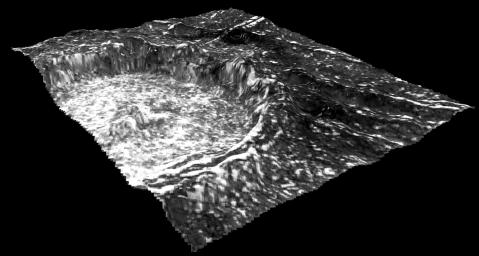
|
3-D Cilix Crater on Europa
- Click the image above for a larger view
- Full-Res JPEG (1337 x 715) (132.0 kB)
- Full-Res TIFF (1337 x 715) (957.1 kB)
Caption:
This view of Cilix impact crater on Europa was created in 2013 using 3-D stereo images taken by NASA's Galileo spacecraft, combined with advanced image processing techniques. The crater has a diameter of about 11 miles (18 kilometers).
This image, which combines a 3-D Digital Elevation Model, or DEM, with original imagery, shows that the crater rim rises steeply for about 980 feet (300 meters) above a flat crater floor that is interrupted by a central peak which has a height of about 660 feet (200 meters). Such central peaks are common on other bodies in the solar system. Young, well-preserved craters like Cilix are rare on Europa's surface, where ongoing geologic activity is thought to disrupt most surface features over timescales of tens of millions of years.
Background Info:
For more information about Europa, visit: http://solarsystem.nasa.gov/europa/home.cfm .
JPL is a division of the California Institute of Technology in Pasadena.
Cataloging Keywords:
| Name | Value | Additional Values |
|---|---|---|
| Target | Europa | |
| System | Jupiter | |
| Target Type | Satellite | |
| Mission | Galileo | |
| Instrument Host | Galileo Orbiter | |
| Host Type | Orbiter | |
| Instrument | ||
| Detector | ||
| Extra Keywords | Crater, Grayscale, Impact | |
| Acquisition Date | ||
| Release Date | 2014-01-08 | |
| Date in Caption | ||
| Image Credit | NASA/JPL-Caltech | |
| Source | photojournal.jpl.nasa.gov/catalog/PIA17851 | |
| Identifier | PIA17851 | |
